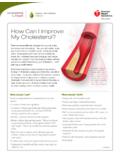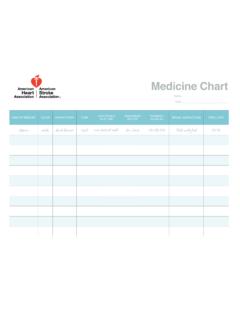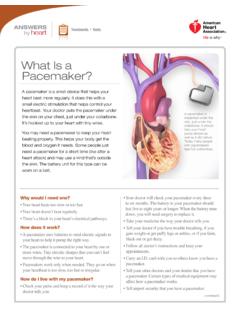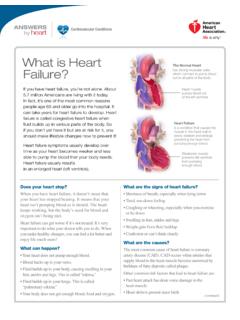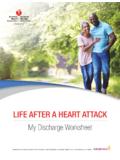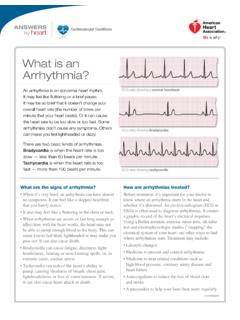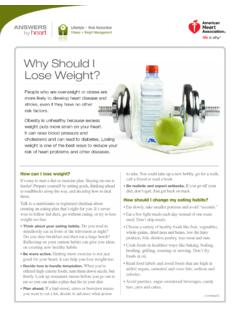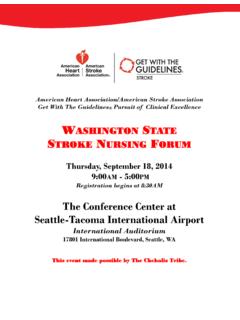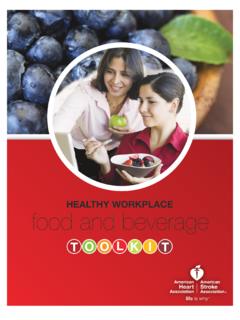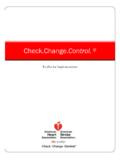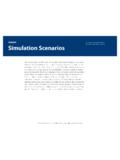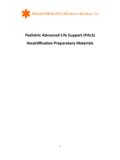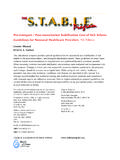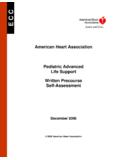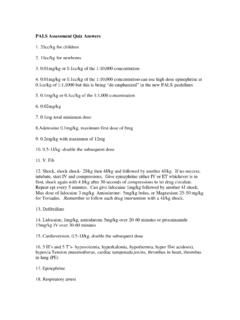Transcription of RESUSCI RESUSCITATION T A FACT SHEET TIO N R
1 PAGE 1 RESUSCITATION FACT SHEET Get With The Guidelines - RESUSCITATION is the American Heart Association s collaborative quality improvement program demonstrated to improve adherence to evidence-based care of patients who experience an in-hospital RESUSCITATION event or received post cardiac arrest care following an in-hospital or out-of-hospital event. The program facilitates the efficient capture, analysis and reporting of data that empowers and supports the implementation of current guidelines, creation and dissemination of new knowledge, and development of next generation, evidence-based practice in RESUSCITATION science. Hospitals are able to track data for Cardiopulmonary Arrest (CPA), Medical Emergency Team (MET), Post-Cardiac Arrest Care (PCAC) and Acute Respiratory Compromise (ARC) in the Web-based Patient Management Tool (powered by Quintiles Real-World & Late Phase Research).
2 The PMT provides decision support, robust registry, real-time benchmarking capabilities and other performance improvement methodologies toward the goal of enhancing patient outcomes and saving lives. The primary goal of Get With The Guidelines- RESUSCITATION is to save more lives by preventing in-hospital cardiac arrest and optimizing outcomes through benchmarking, quality improvement, knowledge translation, and research. CARDIOPULMONARY ARREST ADULT age >=18 years PEDIATRIC age <18 years and >=1 year NEONATE/INFANT age <1 year and >=24 hours old NEWLY BORN event occurred at delivery (< 24 hours old) Confirmation of airway device placement in trachea: Percent of events who had confirmation of airway device placement in trachea. Confirmation of airway device placement in trachea: Percent of events who had confirmation of airway device placement in trachea Confirmation of airway device placement in trachea: Percent of events who had confirmation of airway device placement in trachea.
3 Confirmation of airway device placement in trachea: Percent of events who had confirmation of airway device placement in trachea. Time to first shock <= 2 min for VF/pulseless VT first documented rhythm: Percent of eventswith VF/pulseless VT first documented rhythm in whom time to first shock <=2 minutes of event recognition. Time to first chest compressions 1 min in pediatric patients: Percent of events where time to first chest compressions 1 minute Time to first chest compressions 1 min in pediatric patients: Percent of events where time to first chest compressions 1 minute Advanced airway placed prior to the initiation of chest compressions: Percent of events who had an advanced airway (either laryngeal mask airway (LMA), endotracheal tube (ET) or tracheostomy tube) placed prior to initiation of chest compressions. Time to IV/IO epinephrine 5 minutes for asystole or Pulseless Electrical Activity (PEA): Percent of events where time to epinephrine 5 minute of asystole or pulseless electrical activity.
4 Time to IV/IO epinephrine 5 minutes for asystole or Pulseless Electrical Activity (PEA): Percent of events where time to epinephrine 5 minute of asystole or pulseless electrical activity. Time to IV/IO epinephrine 5 minutes for asystole or Pulseless Electrical Activity (PEA): Percent of events where time to epinephrine 5 minute of asystole or pulseless electrical activity. Pulse oximetry in place prior to the initiation of chest compressions: Percent of events where pulse oximetry was in place prior to the initiation of chest compressions Percent pulseless cardiac events monitored or witnessed: Percent of pulseless cardiac patient events were monitored or witnessed Percent pulseless cardiac events occurring in an ICU setting: Percent of pulseless cardiac events occurring in an ICU setting (Adult ICU, PICU Pediatric Cardiac ICU, Neonatal ICU) versus a general inpatient area (General inpatient area, Step down/telemetry, Newborn Nursery) Percent pulseless cardiac events occurring in an ICU setting.
5 Percent of pulseless cardiac events occurring in an ICU setting (Adult ICU, PICU, Pediatric Cardiac ICU, Neonatal ICU) versus a general inpatient area (General inpatient area, Step down/telemetry, Newborn Nursery) Time to positive pressure ventilation <1 minute from CPA recognition: Percent of events where the positive pressure ventilation was within 1 minute of event recognition. R RESUSCIT A TION R F ACTSHEET MAY 2017 PAGE 2 QUALIT Y MEASURES ACUTE RESPIRATORY COMPROMISE ADULT age >=18 years PEDIATRIC age <18 years and >=1 year NEWBORN/NEONATE/INFANT age <1 year Device confirmation of correct endotracheal tube placement: Percent of events with an endotracheal tube placement confirmed to be correct Device confirmation of correct endotracheal tube placement: Percent of events with an endotracheal tube placement confirmed to be correct Device confirmation of correct endotracheal tube placement: Percent of events with an endotracheal tube placement confirmed to be correct Time to first assisted ventilation 1 min: Percent of events with time to first assisted ventilation 1 minute Time to first assisted ventilation 1 min.
6 Percent of events with time to first assisted ventilation 1 minute Invasive airway inserted in newborn/ neonate events: Percent of events with an invasive airway inserted Time to first assisted ventilation 1 min: Percent of events with time to first assisted ventilation 1 minute Time to invasive airway 2 min in newborn/neonates: Percent of events with time to invasive airway 2 minutes CARDIOPULMONARY ARREST ADULT age >=18 years PEDIATRIC age <18 years and >=1 year NEWBORN/NEONATE/INFANT age <1 year Chest compressions provided: Percent of events with chest compressions provided Defibrillation shock provided for VF/ pulseless VT rhythm: Percent of VF/ pulseless VT rhythm events provided with defibrillation shock IV/IO Epinephrine/Vasopressin bolus administered to pulseless adults 5 min: Percent of events with first documented pulseless rhythm of Asystole or Pulseless Electrical Activity (PEA) for whom IV/IO Epinephrine/Vasopressin bolus was administered within 5 minutes of identification of pulselessness Subsequent shock delivered 2 min after previous shock: Percent of events where any subsequent shock was delivered greater than or equal to 2 min after the previous shock Chest compressions provided: Percent of events with chest compressions provided Defibrillation shock provided for VF/ pulseless VT rhythm: Percent of VF/ pulseless VT rhythm events provided with defibrillation shock Initial shock energy 2 joules/kg (<12 yrs old AND <50 kg).
7 Percent of events for patients less than 12 years old and 50 kg with initial shock energy 2 joules/kg IV/IO Epinephrine/Vasopressin bolus administered to pediatric patients or newborn/neonates 5 min: Percent of events with first documented rhythm of Bradycardia or Asystole or Pulseless Electrical Activity (PEA) for whom IV/IO Epinephrine/Vasopressin bolus was administered within 5 minutes of first recognition of the need for chest compressions Chest compressions provided: Percent of events with chest compressions provided Defibrillation shock provided for VF/ pulseless VT rhythm: Percent of VF/ pulseless VT rhythm events provided with defibrillation shock Initial shock energy 2 joules/kg (<12 yrs old AND <50 kg): Percent of events for patients less than 12 years old and 50 kg with initial shock energy 2 joules/kg Invasive airway inserted in newborn/ neonates: Percent of events with insertion of an invasive airway Percent pulseless cardiac events monitored or witnessed (newborn/ neonate patients): Percent of pulseless events monitored or witnessed RESUSCIT A TION R F ACTSHEET MAY 2017 PAGE 3 CARDIOPULMONARY ARREST (CONTINUED FROM PAGE 02) ADULT age >=18 years PEDIATRIC age <18 years and >=1 year NEWBORN/NEONATE/INFANT age <1 year Shock energy 10 joules/kg (<12 yrs old AND <50 kg): Percent of events for patients less than 12 years old and 50 kg with appropriate shock energies less than or equal to 10 joules/kg Subsequent shock delivered 2 min after previous shock.
8 Percent of events where any subsequent shock was delivered greater than or equal to 2 min after the previous shock Subsequent shock energy 4 joules/kg (<12 yrs old AND <50 kg): Percent of events for patients less than 12 years old and 50 kg with subsequent shock energy 4 joules/kg Time to first shock 2 min for VF/ pulseless VT first documented rhythm: Percent of initially pulseless events with VF/ pulseless VT first documented rhythm with time to first shock 2 minutes IV/IO Epinephrine bolus administered to pediatric patients or newborn/ neonates 5 min: Percent of events with first documented rhythm of Bradycardia or Asystole or Pulseless Electrical Activity (PEA) for whom IV/IO Epinephrine/ Vasopressin bolus was administered within 5 minutes of first recognition of the need for chest compressions Shock energy 10 joules/kg (<12 yrs old AND <50 kg): Percent of events for patients less than 12 years old and 50 kg with appropriate shock energies less than or equal to 10 joules/kg Subsequent shock delivered 2 min after previous shock: Percent of events where any subsequent shock was delivered greater than or equal to 2 min after the previous shock Subsequent shock energy 4 joules/kg (<12 yrs old AND <50 kg).
9 Percent of events for patients less than 12 years old and 50 kg with subsequent shock energy 4 joules/kg Time to Bag mask ventilation <1 minute from CPA recognition in newborn/neonates <10 minutes old: Percent of events in patients <10 minutes old with bag mask ventilation within one minute of event recognition (date/time the need for chest compressions and/or defibrillation for VF/PVT was first recognized). RESUSCIT A TION R F ACTSHEET MAY 2017 PAGE 4 REPORTING MEASURES ACUTE RESPIRATORY COMPROMISE ADULT age >=18 years PEDIATRIC age <18 years and >=1 year NEWBORN/NEONATE/INFANT age <1 year Length of ARC Event: Time from the need for emergency assisted ventilation first recognized to time of the BEGINNING of sustained ROSV or control of ventilation or need for chest compression and/or defibrillation (CPA) first identified Reason ARC event ended: Histogram breakdown of reason event ended Length of ARC Event: Time from the need for emergency assisted ventilation first recognized to time of the BEGINNING of sustained ROSV or control of ventilation or need for chest compression and/or defibrillation (CPA) first identified Reason ARC event ended: Histogram breakdown of reason event ended Length of ARC Event.
10 Time from the need for emergency assisted ventilation first recognized to time of the BEGINNING of sustained ROSV or control of ventilation or need for chest compression and/or defibrillation (CPA) first identified. Reason ARC event ended: Histogram breakdown of reason event ended CARDIOPULMONARY ARREST ADULT age >=18 years PEDIATRIC age <18 years and >=1 year NEWBORN/NEONATE/INFANT age <1 year Adult and pediatric patients with pulseless cardiac events who died that had DNAR status declared and/ or life support withdrawn: Histogram breakdown of pulseless events where patients died and had DNAR status declared and/or life support withdrawn Adult patients with pulseless cardiac event who survived and CPC scores at hospital discharge: Histogram breakdown of patients with pulseless events who survived and CPC scores at hospital discharge Average ventilation rate: Percent of events with average ventilation rate of <12 breaths/min Chest compression depth: Percent of events with an average chest compression depth of 50mm Chest compression fraction.
